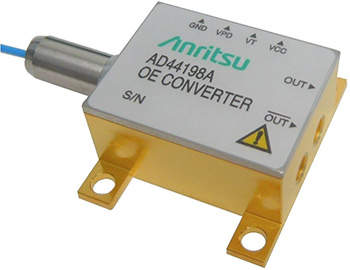Anritsu Corporation (President Hirokazu Hamada) is launching its newly developed wideband 56-Gbaud OE Converter AD44198A on December 20.
With wide frequency characteristics of 45 GHz in the –3 dB band, this new device supports OE conversion of PAM4*1 optical signals between 28 and 56 Gbaud. The wide optical wavelength range covers the O- to L-bands, and the built-in, low-noise TIA features both a high optical sensitivity of 250 V/W @ 1310 nm, and a low noise evaluation power (NEP) *2 of 8 µWrms.
This OE converter can be used as the optical IF receiver in semiconductor testers required for evaluating high-speed, high-quality waveforms as well as in the frontend of measuring instruments for testing PAM4 optical signals.
Development Background
The optical-interconnect market has grown rapidly in recent years to support development of devices supporting larger capacities and faster speeds, but semiconductor testers for evaluating these devices are also required for fast evaluation of high-quality waveforms.
To meet these needs, Anritsu has developed this wideband OE converter based on our experience of optical device technologies in the communications market as a key device for semiconductor testers and measuring instruments.
Product Outline
This wideband OE converter supports high-baud-rate optical interfaces for 56-Gbaud PAM4 signals in the semiconductor tester and measuring-instrument markets. It covers an optical Rx wavelength range of 1260 to 1620 nm and a frequency band from 30 kHz to 45 GHz; the built-in, low-noise TIA features a conversion gain of 250 V/W and a high optical Rx sensitivity. In addition, the small (6 cm3) metal package is not only ideal for semiconductor-tester and measuring-instrument frontend applications but is also applicable to optical modulators.
Target Markets and Applications
- Target Markets
- Semiconductor testers, semiconductor automated test equipment, optical-signal test equipment
- Applications
- Evaluation of 26 and 56-Gbaud, high-speed optical devices
Technical Terms
- *1 PAM4
- PAM is the abbreviation for Pulse Amplitude Modulation which increases transmission capacity using amplitude modulation. PAM4 is a 4-value amplitude modulation method.
- *2 Noise Evaluation Power (NEP)
- Incident optical quantity equal to noise quantity. Or Incident optical quantity when SN ratio = 1.
For more information, visit www.anritsu.com







